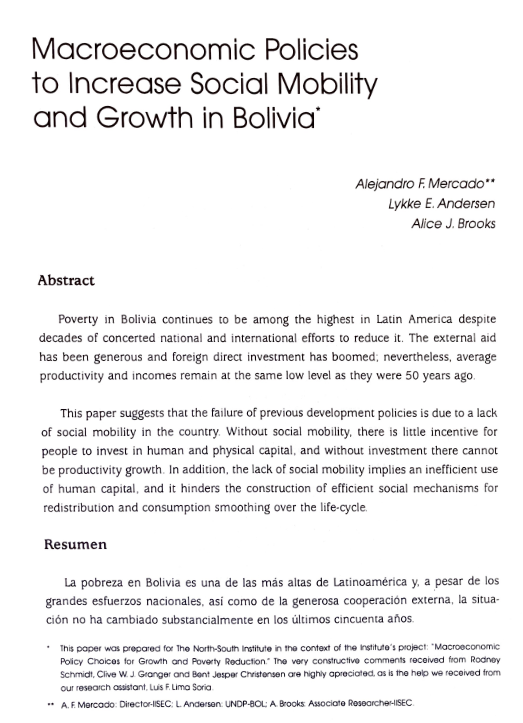Macroeconomic Policies to Increase Social Mobility and Growth in Bolivia
DOI:
https://doi.org/10.35319/lajed.20050262Keywords:
Poverty, Social mobility, Economic growthAbstract
Poverty in Bolivia continues to be among the highest in Latin America despite decades of concerted national and international efforts to reduce it. The external aid has been generous and foreign direct investment has boomed; nevertheless, average productivity and incomes remain at the same low level as they were 50 years ago.
This paper suggests that the failure of previous development policies is due to a lack of social mobility in the country. Without social mobility, there is little incentive for people to invest in human ad physical capital, and without investment there cannot be productivity growth. In addition, the lack of social mobility implies an inefficient use of human capital, and it hinders the construction of efficient social mechanisms for redistribution and consumption smoothing over the life-cycle.
Downloads
References
Andersen, Lykke E. 2001a. “Social Mobility in Latin America: Links with Adolescent Schooling”. Inter-American Development Bank. Research Network Working Paper No. R-433.
Andersen, Lykke E. 2001b. “Low Social Mobility in Bolivia: Causes and Consequences for Development”. Institute for Socio-Economic Research, Universidad Católica Boliviana Working Paper No. 3/2001, May.
Andersen. Lykke E. and José L. Evia 2003 “The Effectiveness of Foreign Aid in Bolivia” Institute for Socio-Economic Research, Universidad Católica Boliviana. Working Paper No. 10/2003, December.
Andersen, Lykke E. and Beatriz Muriel, 2002. “Cantidad versus calidad en educación implicaciones para la pobreza” Revista de Estudias Económicos y Sociales, Vol. 1, pp. 9-41.
Baumol, William J., 1990. “Entrepreneurship Productive. Unproductive and Destructive”. Journal of Political Economy. Vol. 98(5), pp. 893-921.
Becker, Gary S. 1991. A Treatise on the Family. Enlarged Edition. Cambridge, Mass.: Harvard University Press.
Behrman, Jere R., Nancy Birdsall and Miguel Székely. 1998, “Intergenerational Schooling Mobility and Macro Conditions and Schooling Policies in Latin America”. Inter-American Development Bank, Office of the Chief Economist. Mimeo.
CEDLA. 2003. “Servicio de crecimiento y reducción de la pobreza un callejón sin salida”. La Paz.
Dahan, Momi and Alejandro Gaviria. 2000 “Sibling Correlations and Social Mobility in Latin America”. Inter-American Development Bank, Office of the Chief Economist Draft, March.
Fields, Gary S. 1996. “Accounting for Differences in Income Inequality”. Draft, School of Industrial and Labor Relations, Cornell University, January.
Galor, Oded and Daniel Tsiddon. 1997. “Technological Progress, Mobility, and Economic Growth”. American Economic Review 87(3), 363-382.
Hassler, John and José V. Rodriguez Mora. 2000. “Intelligence, Social Mobility and Growth”. American Economic Review 90(4), 888-908.
Hassler, John, José V. Rodriguez Mora and Joseph Zeira. 2002. “Inequality and Mobility”. Institute for International Economic Studies, Stockholm University, January.
Kaufmann Daniel, Máximo Mastruzzi and Diego Zavaleta. 2003. Chapter 12 in In Search of Prosperity: Analytic Narratives on Economic Growth. Ed. D. Rodrik, Princeton University Press.
Kaufmann D, G. Mehrez and T. Gurgur. 2001. “Voice or Public Sector Management?: A Model and Analysis based on a Survey of Public Officials”. The World Bank.
Kremer, Michael, 1996. “How much does sorting increase inequality?” NBER Working Paper No. 5566. May.
Mercado, Alejandro F., Lykke E. Andersen, Osvaldo Nina and Mauricio Medinaceli.
----------. 2003. “Modelo alternativo de desarrollo: una agenda de políticas para la nueva década”. Final Report. IISEC/PIEB. December.
Mercado, Alejandro F., Lykke E. Andersen and Beatriz Muriel 2003, “Discriminación étnica en el sistema educativo y el mercado de trabajo de Bolivia”. Latin American Journal of Economic Development, Vol. 1, pp. 11-36.
Morales, Juan Antonio. 1995. “Los problemas postestabilización en Bolivia”. En Inflación, estabilidad y crecimiento, Institute for Socio-Economic Research, Universidad Católica Boliviana.
Morales, Juan Antonio and Jeffrey Sachs. 1990. “Bolivia's Economic Crisis”. In Sachs,
Jeffrey (ed.) Developing Country Dept and Economic Performance. Vol. 2. Chicago: University of Chicago Press.
Murphy, Kevin M., Andrei Schleifer and Robert W. Vishny. 1991. “The Allocation of Talent: Implications for Growth”. Quarterly Journal of Economics. Vol 106(2): 503-530.
Navajas, Sergio. 2000. “Microcredit and the poorest of the poor: Theory and evidence from Bolivia”. Preliminary version of the published in World Development Vol. 28. No, 2, pp 233-346.
Nina, Osvaldo and Dirk Willem te Velde 2003. “Foreign Direct Investment and Development The Case of Bolivia” Carta Informativa No. 1, Grupo Integral, La Paz, Mayo.
Pritchett, Lant. 1996. “Where has all the education gone?” Policy Research Washington, D.C.: The World Bank, March Working Paper No. 1581.
Raut, Lakshmi K. 1996. “Signalling equilibrium, Intergenerational mobility and long-run growth”. University of Hawaii-Manoa. Draft. February.
Székely, Miguel and Marianne Hilgert. 1999. “What's Behind the Inequality We Measure: An Investigation Using Latin American Data for the 1990s”. Research Department at the Inter-American Development Bank. Draft, December 3.
Transparency International. 2003. The 2003 Corruption Perception Index.
UNESCO. 1998. Primer estudio international comparativo sobre lenguaje, matemática y Focatores Asociados en Tercero y Cuarto Grado. Santiago, Chile.
Urquíola, Miguel. 2000. “Educación primaria universal”. In: UNDP (2000). Remontando la pobreza: ocho cimas a la vez. La Paz: EDOBOL.






